
Following decades of seemingly irreversible decline, the Irrawaddy River dolphin population in the Mekong region is rebounding. According to a recent census released by WWF and the Government of Cambodia, the number of these critically endangered dolphins has risen from 80 to 92 in the past two years—the first increase since scientists began keeping records more than twenty years ago.
This historic population increase can be attributed to several factors, including more effective patrolling by river guards and an increase in the confiscation of illegal gillnets, which can trap and drown dolphins. Over the past two years, guards have confiscated more than 200 miles of illegal gillnets—almost double the length of the dolphins’ remaining home range—from core dolphin habitat.
“Thanks to the combined efforts of the government, WWF, the tourism industry, and local communities, we finally have reason to believe that these iconic dolphins can be protected against extinction,” said Seng Teak, Country Director of WWF Cambodia. “The tour boat operators are the secret ingredient of this success story—they work closely with law enforcement to report poaching and help confiscate illegal gillnets.”
The first official census in 1997 estimated that there were 200 Irrawaddy dolphins in the Mekong, a figure that fell steadily due to bycatch and habitat loss. By 2015, only 80 dolphins remained.
Now, growing numbers are an encouraging sign for the long-term survival of the species. More dolphins are surviving into adulthood, and there’s been a significant drop in overall deaths. Nine calves were born this year, raising the number of dolphins born in the past three years to 32.
The census also has positive implications for the Greater Mekong region, where countless communities and species rely on healthy river systems and the natural resources they provide.
“River dolphins are indicators of the health of the Mekong River, and their recovery is a hopeful sign for the river and the millions of people who depend on it,” added Teak. “We celebrate this good news, but we need to re-double our efforts to protect the dolphins—for their future, for the river, and for the communities that live alongside it.”
Learn more about free-flowing rivers and how they’re essential for the continued survival of species like the Irrawaddy dolphin.
Published April 23, 2018 at 05:00AM
No comments:
Post a Comment